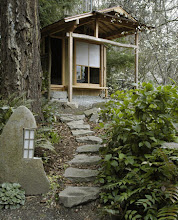
An old cob cottage about to be invaded by weekenders.
The Earth has voted on the best low cost building material to make houses with and it is....the earth itself! Recently we read that 70% of all buildings are made from earth (and that's not even including made-into-bricks or turned-into-concrete varieties). Besides these more common techniques, earth can be rammed, baked, put in sacks, pushed into tyres, shoveled on top of you, or any other method our sandbox minds can come up with.
We have a feeling earth is going to win our Cheapest House Challenge (at least in the materials cost department), it sure is hard to beat stuff that is already delivered free, to even the most barren of lots. Clay and sand can sometimes be found at different levels of the same soil. And while the above earth-stacking methods have their adherents, for our money you can't go past the tried and tested, D.I.Y., nothing-else-needed technique of cob.
Cob is the name for the particular ratio of clay-rich earth, sand and water, blended with hay, that forms a solid, durable building material. Usually also seen with stone for a base, these cob-and-stone buildings were the most common low cost home in pre-industrial Britain, when bricks took over to meet the needs of a large, urban population.
It is said that almost anyone can learn to build with cob, and that the technique lends itself to personal, perpetually adaptable, and a lovely slightly "wobbly" result. A cob building needs no structural formwork, and so it bypasses the need for carpentry skills. There are loads of cob building tutorials and information on the web, and we'll link to some of the best. One site that grabbed our attention was the Cob Cottage Company, who mention a $500 cottage their founders have lived in for years. No specific plans or photos were supplied, but using recycled features and group labor, the principle is sound. (And it sure is nice to think you don't have to beg your bank for a high interest loan, but can build your house with the kind of money you might make from a yard sale instead.)

The one thing cob houses don't have is speed - it takes about a day (with a whole bunch of helpers) to build about a foot of wall. But as a low cost building method it can't be beat. Helping speed things up is getting the right machinery (from hand held electric plows, concrete mixers, or bobcats) can make the job faster, and without a mortgage on your back would free up plenty of time!
There are a few basic tricks you need to know with cob building (but no less than any other material). One is cob must be protected from water, which necessitates high footings of stone or concrete for the cob to sit on (see below), and a roof that protects the walls from too much rain (the 'cap and boot' method). Applying a few layers of linseed oil to the surface also helps.

Another point to keep in mind is that cob needs to "breathe". Many people today in the UK, mistaking old cob buildings for stone, have painted them with contemporary paints, allowing moisture to build up inside the cob, and forming serious cracks. Cobs need only a lime plaster to cover their outside, which is usually white in appearance, but can be tinted to most any soft color.

Low cost homes that are also low fuel-bill, eco homes are a charm, and beat an energy-sucking trailer for a mile. Cob walls are thick (providing excellent thermal properties) to provide structural strength. Most contemporary cob buildings have curved walls to increase wall strength (or combine buttresses or built-in internal cob furniture, like fireplaces or chairs). We seem to have forgotten the technology somewhat of how to build the long, straight walls we see in old cob buildings from Europe.
Planning Permission.
While cob can be used for your whole structure with a roof on top, it's said that submissions to government authorities can be smoothed over by placing load bearing timbers, perhaps at the corners of rooms or around windows and doors. If these support the roof, you essentially have a pole house, and most won't be too fussed about what "fills" the space in between the poles.In discussions with authorities, it is perhaps best to mention that you are not building a low cost home or using low cost building materials, rather, you are using a design that will fit in with the heritage of the area.

There are cob building workshops you can find in most countries once you tap into the networks. Cob building is such a social (and human labor run) activity that if you hear of any cob-building activity we suggest you volunteer your services. Helping out is the best way to learn; and once you are confident enough to build your own structure you can advertise for (and educate) more would-be cob interest volunteers.
For more cob information on low cost building with cob:
The Cob Builder's Handbook
A nice rundown by a couple building a 400 sq. ft. cob home, including receipts! - $10,000 in total, almost half of which was for the cement floor. See some low cost cob-compatible flooring alternatives here.





